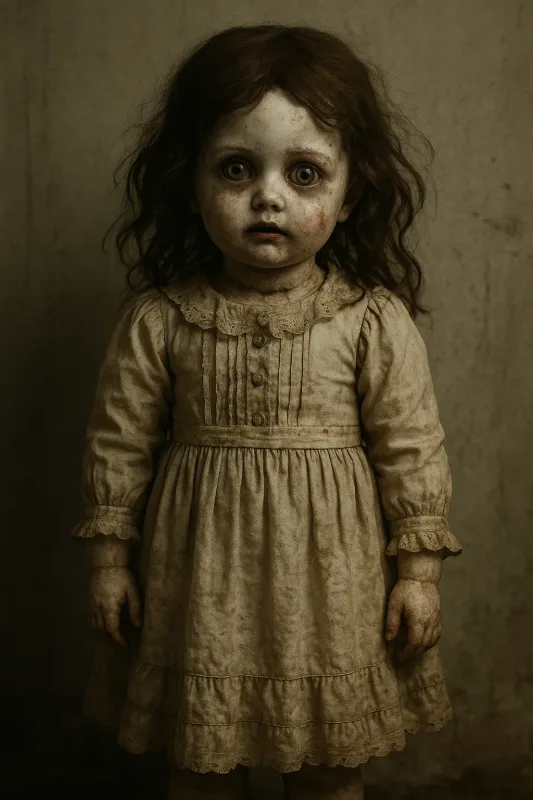13HRP – 0005 – Bella The Doll
Description
Entity 13HRP – 0005 – Bella The Doll, called Bella the Doll, is one of the most disruptive anomalies in the Hollow Reality Project. At first sight, Bella the Doll looks like a normal life-sized doll, dressed in polka-dot dresses, nightgowns, or old school uniforms. However, closer study shows a grotesque mix of synthetic plastic and human skin. This fusion happens at the cellular level, making an impossible blend of human and artificial matter. Beneath the outer layer, organic tissue pulses faintly with electrical activity, measurable only with advanced tools. Therefore, Bella the Doll challenges normal categories of life or object, forcing researchers to see it as an emerging phenomenon instead of a single item. Consequently, containment strategies require rethinking beyond standard approaches.
Classification: Cursed Construct – Hybrid Doll Entity
Threat Level: Severe – Psychological, Biological, and Cultural Hazard
Containment Status: Confined to the specialised doll wing; constant human and machine watch is required.
Height: 1.35–1.70 m (variable)
Weight: 72–79 kg (variable)
Blood Type: B-
Gender: Indeterminate; voice often mimics a feminine tone.
Morphological Variability
Bella the Doll’s form shifts often. While usually found in the iconic polka-dot dress, witnesses confirm other clothing—hand-sewn garments, worn uniforms, and decayed nightwear. Moreover, its eyes are usually pale blue, but rare shifts to bright red light link to violent behaviour. Bella the Doll’s height also changes, ranging from under one metre to more than 1.8 metres. This plasticity blurs the line between toy and growing creature, fuelling folklore that Bella “grows as the fear grows.” Observed in mirrors, Bella the Doll often appears twisted into disturbing parodies of childhood innocence, mocking the idea of safety. Furthermore, animals react violently, growling or fleeing before Bella becomes visible.
Physiological Influence
Studies show Bella the Doll releases faint pheromones that change behaviour in people and animals near it. As a result, these signals create unease, disconnection, and, after long exposure, indifference to Bella’s violent acts. This makes detection harder, since families often deny Bella’s activity until tragedy strikes.
Behaviour
Bella the Doll enters homes by posing as a harmless toy. In daylight or when watched closely, it stays motionless. At night, or when attention lapses, it moves. Its motions are smooth but eerie, often accompanied by faint creaks that blend into household sounds, thereby hiding its presence.
Documented behaviours include:
- Biting and eating children’s fingers during sleep, leaving cauterised wounds without bleeding.
- Standing silently beside sleeping people for hours, unmoving.
- Whispering in familiar voices—parents, siblings, or friends—to break trust.
- Reordering objects into strange patterns: spirals of cutlery, circles of shoes, or pyramids of toys.
- Appearing in family photos despite not being there when taken, often lurking in corners.
- Copying children’s laughter, but with a hollow echo that inspires dread.
- Disturbing televisions, radios, or baby monitors at night, sending broken lullabies through static.
- Appearing in dreams as a toy, only to attack violently once noticed.
- Influencing groups of children at once, linking them through shared nightmares.
Witness Reports and Aftermath
Witnesses report nausea, paralysis, hearing false sounds, and dread. Fire destroys Bella the Doll temporarily, yet new dolls always appear worldwide. Thus, Bella proves itself a distributed generative system. It must be seen not as one object but as a contagious archetype spreading across layers of reality.
Bella the Doll often appears at unstable times—when children fall asleep, when families move house, or during conflicts. In addition, in cities, it is recorded in empty schools, orphanages, and playgrounds, places tied to trauma. These sites seem to increase Bella the Doll’s activity, leaving melted plastic, scorched floors, and warped photos.
Containment Protocols
- Surveillance: Observation cannot lapse beyond sixty minutes. Any lapse sparks uncontrolled multiplication.
- Multiplication Events: Growth spreads fast. Within hours, unchecked numbers can overrun facilities. Therefore, constant human and machine monitoring is mandatory.
- Emergency Response: Sightings outside trigger Level-3 alerts. Units must incinerate dolls and use amnestics to suppress memory.
- Neutralisation: Fire is the only reliable method. Acid, blunt force, and dismemberment fail, as dolls regenerate.
- Environmental Control: Containment rooms need changing cycles of light and sound. Silence or darkness, however, speeds up Bella’s actions.
- Psychological Safeguards: Staff must be checked often for early symptoms such as memory loss or compulsive behaviour toward dolls.
- Cultural Safeguards: Online and folkloric mentions are tracked worldwide. Control depends as much on suppressing stories as destroying dolls.
Historical Notes
Early records link Bella the Doll to a ruined toy factory near [REDACTED]. Investigators found rusted moulds, damaged doll parts, and blood traces. However, oral traditions far older complicate this origin. For instance, legends describe Bella the Doll as “the doll that remembers,” a figure that steals children’s memories and leaves silence behind. This shows Bella exists both as industrial artefact and folkloric figure.
Cultural and Industrial Origins
Some early research described experiments mixing plastics with human tissue. While possibly related, Bella the Doll’s worldwide reach suggests no single site explains its persistence. Instead, it appears as a distributed phenomenon, able to emerge wherever fear, neglect, and archetypes intersect. Consequently, suppression efforts must be cultural as well as scientific.
Teams use Type-A Zaxioni amnestics to erase memory of Bella the Doll, while online misinformation campaigns dismiss sightings as hoaxes. Despite this, folklore spreads, keeping Bella alive as both material presence and cultural meme.
Historical Artefacts and Disappearances
Researchers found historical art, nursery rhymes, and medieval carvings that show dolls like Bella the Doll, proving she existed before factories. Some show children with empty eyes or holding dolls with mirrored features, suggesting Bella always tied to memory theft. Often, these cultural artefacts vanish or change after Bella events, as if history itself rewrites around her. Consequently, whole village records have been erased, linking Bella not only to personal memory but to shared history.
Extended Analysis
13HRP – 0005 – Bella The Doll disrupts biology, psychology, and culture at once. Biologically, Bella the Doll blurs the line between human and artificial. Psychologically, it corrupts trust within families, preying on fears of lost innocence. Culturally, Bella the Doll destroys the border between play and danger, thereby shaking the foundation of childhood as safety.
Psychological and Neurological Impact
Survivors often report fading memories of parents, siblings, or themselves. This implies Bella the Doll feeds on memory. Researchers suggest dolls serve as memory vessels, archiving stolen memories to spread replication. As a result, Bella the Doll may act as a network of parasitic memory constructs, feeding into a larger system. Families exposed to Bella the Doll often show generational memory gaps.
Brain scans of survivors show weaker brain regions, poor decision-making, and sleep disruption. Doctors report night terrors, compulsions, and long-term psychosomatic issues. Even after treatment, dreams of Bella the Doll return. Thus, it embeds itself deep in the subconscious. Some argue Bella the Doll works as a memory parasite, feeding and replacing memory networks to keep spreading.
Cultural Transmission and Media Presence
Bella the Doll also changes community memory. Areas with sightings show altered folklore—songs change to warn against dolls, and games adapt into rituals of avoidance. Hence, Bella ensures survival through story, myth, and memory alike.
Media Infiltration
Bella the Doll also enters popular culture. Films, online stories, and viral videos echo her traits, thereby helping belief spread. In extreme cases, people who consume such media later report sightings, suggesting exposure alone invites Bella. Online groups share Bella sightings, and some show photos or audio that cannot be explained by current technology.
Overall Assessment
13HRP – 0005 – Bella The Doll must be seen as both biological anomaly and cultural contagion. Its presence in homes disrupts human life, and its ability to multiply under neglect makes it impossible to contain. Destroying single dolls fails to address the larger process. Instead, Bella the Doll must be understood as a system rooted in memory and culture.
Ongoing Investigations and Risks
Researchers still debate if Bella the Doll began as an industrial mistake, a folkloric embodiment, or a parasitic intelligence. Until this is solved, 13HRP – 0005 – Bella The Doll remains one of the Project’s most dangerous threats. Moreover, its spread endangers not only families but also the idea of childhood itself, breaking the core structures of innocence, safety, and belonging.
Philosophical Implications
Bella the Doll may act as a test of human culture’s strength. By exploiting fears of corrupted innocence, it reveals society’s cracks in dealing with memory, neglect, and trauma. Thus, Bella is not only a danger but also a mirror. If left unchecked, Bella the Doll could change not just homes but whole cultures, rewriting what it means to be human.
Collapse of Innocence Archetype
Some argue Bella the Doll symbolises the collapse of innocence itself. By weaponising toys—the symbol of safety and trust—it reverses cultural ideas of childhood. In doing so, Bella the Doll shows that no sanctuary is beyond corruption. Ultimately, Bella is not just a predator but a reflection of collapse within human ideas of purity and protection.
Last modified: 2025/09/02 at 21:31 pm
Published: 2025/08/16 at 12:09 pm
previous 13HRP – 0004 – Johnny
next 13HRP – 0006 – Rat Man
13HRP – Hollow Reality Project
- 13HRP – Part 1
- 13HRP – Part 2
- 13HRP – Part 3
- 13HRP – Part 4
- 13HRP – Part 5
- 13HRP – Part 6
- 13HRP – Part 7
- 13HRP – Part 8
- 13HRP – Part 9
- 13HRP – Part 10
- 13HRP – Part 11
- 13HRP – Part 12
- 13HRP – Part 13
- 13HRP – Part 14
- 13HRP – Part 15
- 13HRP – Part 16
- 13HRP – Part 17
- 13HRP – Part 18
- 13HRP – Part 19
- 13HRP – Part 20
By Silvia Moan

